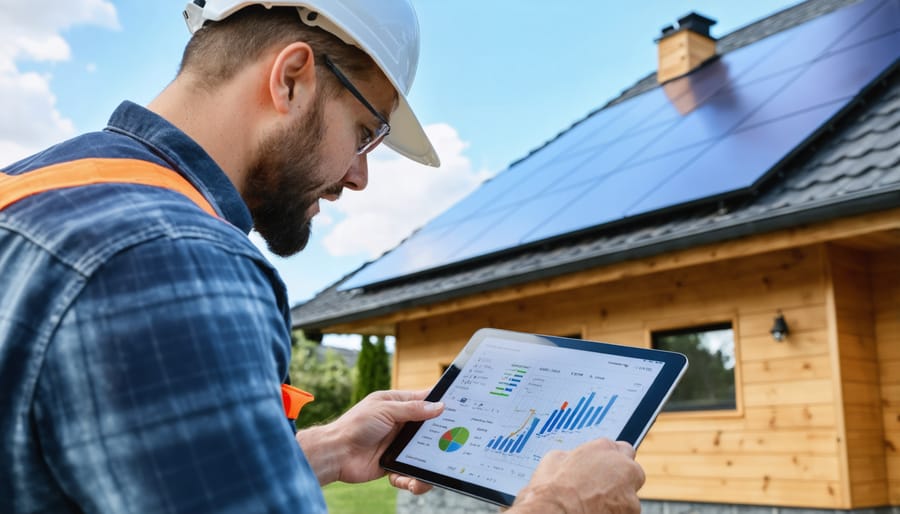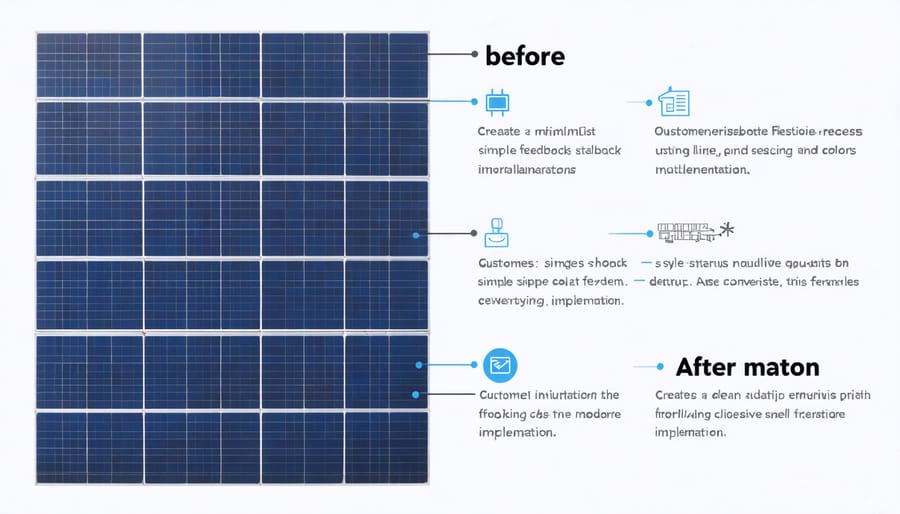Solar customer service excellence drives long-term success in the renewable energy sector. Leading providers consistently stay ahead of customer needs through proactive communication, transparent installation processes, and dedicated post-installation support. As homeowners increasingly embrace solar technology, exceptional service has become the defining factor between thriving installations and frustrated customers.
The solar industry’s rapid growth demands a customer-first approach that combines technical expertise with accessible support. From initial consultation through system maintenance, every interaction shapes the homeowner’s renewable energy journey. Smart solar providers recognize that outstanding service isn’t just about solving problems—it’s about creating confident, satisfied customers who become long-term clean energy advocates.
Modern solar customer service extends beyond traditional support channels, incorporating real-time monitoring, predictive maintenance alerts, and educational resources that empower homeowners to maximize their investment. This comprehensive approach ensures lasting satisfaction while building the trust essential for sustainable industry growth.
The Voice of Solar Customers Matters

Real-World Experience vs Technical Specs
While technical specifications provide important baseline information about solar equipment, real customer experiences often tell a more complete story. Homeowners who have gone through the solar installation process can offer invaluable insights about practical aspects that aren’t covered in product manuals or data sheets. These firsthand accounts help solar companies understand how their personalized solar solutions perform in actual households.
For instance, while a panel’s efficiency rating is crucial, customer feedback might reveal how well the system performs during different seasons, how it handles local weather conditions, or how seamlessly it integrates with existing home energy systems. Real users can share insights about the clarity of monitoring apps, the responsiveness of customer support, and the effectiveness of maintenance services.
This practical feedback helps solar providers bridge the gap between technical promises and real-world performance, leading to better service delivery and more satisfied customers. It also enables companies to refine their installation processes, improve communication methods, and develop more effective solutions for common challenges that might not be apparent from specifications alone.
Building Trust Through Active Listening
Active listening is the cornerstone of exceptional solar customer service. When customers share their experiences, concerns, and questions about solar installations, paying genuine attention and responding thoughtfully builds lasting trust. By carefully noting customer feedback about installation processes, energy savings, and system performance, solar providers can better understand homeowners’ needs and expectations.
Successful solar companies make it a priority to document customer insights and implement changes based on this valuable feedback. Whether it’s streamlining the installation timeline, improving communication methods, or enhancing post-installation support, these adjustments demonstrate a commitment to customer satisfaction.
Creating multiple channels for feedback, such as surveys, follow-up calls, and online reviews, ensures customers feel heard and valued. When solar providers actively respond to reviews and address concerns promptly, it shows potential customers that the company values transparency and continuous improvement.
Remember, trust isn’t built overnight – it’s cultivated through consistent, attentive service and genuine responsiveness to customer needs. By maintaining open lines of communication and acting on feedback, solar providers can establish themselves as reliable partners in their customers’ renewable energy journey.
Turning Feedback into Action
Installation Process Refinement
Customer feedback plays a vital role in refining the solar installation process, making it more efficient and homeowner-friendly. When customers share their experiences, solar companies can identify common pain points and implement practical solutions that benefit future installations.
For example, many homeowners have helped companies develop better pre-installation site assessment procedures by pointing out specific challenges with roof access or electrical panel locations. This valuable input has led to more thorough initial evaluations and fewer surprises during installation day.
Communication improvements often stem directly from customer suggestions. Many solar providers now offer detailed installation timelines, regular progress updates, and clear explanations of each installation phase based on previous customer feedback. Some companies have even developed mobile apps that allow homeowners to track their installation progress in real-time.
Weather-related concerns raised by customers have prompted better scheduling flexibility and backup plans. Installation teams now typically provide weather contingency dates upfront and maintain better communication about potential schedule changes.
Property protection measures have also evolved through customer input. Companies now use improved equipment covers, better debris management systems, and more careful workspace organization techniques to protect homeowners’ property during installation.
These refinements have resulted in shorter installation times, higher customer satisfaction rates, and fewer post-installation issues. The continuous feedback loop between customers and solar providers ensures that installation processes keep improving, making solar adoption easier for future homeowners.

Post-Installation Support Enhancement
After your solar installation is complete, ongoing support becomes crucial for maintaining system performance and customer satisfaction. Leading solar providers now offer comprehensive post-installation support packages that include regular system monitoring, preventive maintenance checks, and rapid response to service requests.
Many companies have introduced user-friendly mobile apps that allow homeowners to track their system’s performance in real-time, schedule maintenance visits, and communicate directly with support teams. These digital tools help identify potential issues before they become problems, ensuring optimal system efficiency and peace of mind for homeowners.
24/7 customer support has become an industry standard, with dedicated teams available to address concerns ranging from simple performance questions to emergency situations. Regular maintenance check-ups, typically scheduled quarterly or bi-annually, help prevent system degradation and maintain peak efficiency.
Performance guarantees and extended warranty programs provide additional security for homeowners, often covering both equipment and energy production. Some providers even offer production monitoring services that automatically alert technical teams if your system’s output falls below expected levels.
Educational resources, including maintenance guides and troubleshooting tips, empower homeowners to handle basic system care independently. This proactive approach to customer support helps maximize the return on your solar investment while ensuring long-term system reliability and customer satisfaction.
Technology Meets Customer Experience
Smart Monitoring Solutions
Customer feedback has revolutionized how solar companies develop and implement smart monitoring solutions for homeowners. Real-world user experiences have led to more intuitive mobile apps, easier-to-read dashboard displays, and customizable alert systems that keep homeowners informed about their solar system’s performance.
Thanks to consistent feedback, modern monitoring platforms now feature user-friendly interfaces that display energy production, consumption, and savings in clear, understandable terms. Homeowners particularly appreciated the addition of weather-aware forecasting and automated maintenance notifications, which were direct results of customer suggestions.
These improvements have made it easier for families to track their solar investment’s performance and make informed decisions about their energy usage. Popular features like real-time energy monitoring and monthly performance reports were developed based on homeowner requests for more transparency and control over their systems.
Companies continue to refine these monitoring tools based on user input, creating features like comparative analysis with similar households and predictive maintenance alerts. This ongoing evolution ensures that solar monitoring keeps pace with homeowner needs while making sustainable living more accessible and manageable for everyone.

Communication Platform Improvements
Modern solar providers have revolutionized their communication platforms based on valuable customer feedback, making it easier than ever for homeowners to stay connected and informed. Many companies now offer user-friendly mobile apps that allow customers to monitor their system’s performance, schedule maintenance, and contact support with just a few taps.
Real-time chat support has become increasingly common, providing instant assistance for urgent questions or concerns. These platforms are typically staffed by knowledgeable solar experts who can quickly address technical issues or billing queries. Companies have also implemented automated notification systems that alert customers about maintenance schedules, weather impacts, and system performance updates.
Multi-channel support options now include text messaging, email, and social media platforms, letting customers choose their preferred method of communication. Video chat consultations have gained popularity, especially for troubleshooting issues that might traditionally require an in-person visit.
Customer portals have been enhanced to include detailed energy production reports, savings tracking, and educational resources. These improvements stem directly from customer suggestions for more transparent and accessible information. The integration of AI-powered chatbots has also streamlined common inquiries, providing instant responses to frequently asked questions while maintaining the option for human interaction when needed.
Measuring Success Through Customer Satisfaction
Customer satisfaction metrics serve as the cornerstone of excellent solar service delivery. Through carefully designed feedback systems, solar providers can track their performance and continuously enhance their service quality. Post-installation surveys, regular check-ins, and real-time feedback channels help companies understand how well they’re meeting customer expectations and where improvements are needed.
One effective method is the Net Promoter Score (NPS), which measures how likely customers are to recommend solar services to others. This simple yet powerful metric helps identify advocates while highlighting areas needing attention. Companies also utilize customer satisfaction surveys that focus on specific aspects of the customized solar experience, from initial consultation to ongoing support.
Digital platforms play a crucial role in gathering feedback. Online reviews, social media engagement, and mobile apps provide valuable insights into customer experiences. Many solar providers now use automated systems to track response times, resolution rates, and overall customer satisfaction trends. This data helps identify patterns and opportunities for service enhancement.
Regular performance reviews of these metrics enable solar companies to implement targeted improvements. For instance, if surveys reveal that customers desire more frequent system performance updates, companies can develop automated reporting systems or enhanced mobile monitoring capabilities. This responsive approach to customer feedback ensures that service quality evolves with customer needs.
Success in solar customer service isn’t just about collecting data – it’s about acting on it. Companies that excel in this area maintain transparent communication with customers about how their feedback shapes service improvements, creating a cycle of continuous enhancement that benefits both providers and homeowners.
Customer feedback remains the cornerstone of excellence in solar service delivery, driving continuous improvement and innovation in the industry. As solar technology evolves and more homeowners embrace renewable energy, the voice of the customer becomes increasingly vital in shaping service standards and practices. Companies that actively listen to their customers’ experiences, concerns, and suggestions are better positioned to deliver solutions that truly meet homeowners’ needs.
The feedback loop between solar providers and customers has already led to significant improvements in installation processes, maintenance services, and communication protocols. Looking ahead, this collaborative approach will continue to be essential as the industry faces new challenges and opportunities. Solar companies that maintain strong customer feedback channels while implementing responsive changes will likely see higher satisfaction rates and stronger customer loyalty.
For homeowners, providing honest feedback about their solar experience not only helps improve individual service quality but also contributes to the broader advancement of sustainable energy adoption. As the solar industry matures, customer insights will remain crucial in developing more efficient, user-friendly, and reliable solar solutions for future generations.









